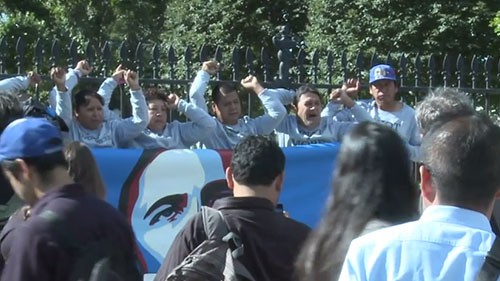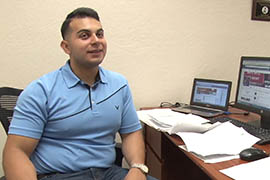Cronkite News has moved to a new home at cronkitenews.azpbs.org. Use this site to search archives from 2011 to May 2015. You can search the new site for current stories.
Arizona DREAMers reapplying for federal deferred-action program
PHOENIX – In March, 24-year-old Franko Milan accomplished his dream of becoming a real estate agent.
Two years before, Milan was jumping between jobs. He was a supermarket courtesy clerk for a while. He worked for two weeks at a sandwich shop. Then he did some construction with his dad.
Milan, who said his parents brought him into the country on a tourist visa when he was 9 months old and stayed illegally, couldn’t get or maintain a job because of a state law requiring employers to use the federal E-Verify system to screen hires.
But in July 2012, President Barack Obama issued an executive order that grants two-year deportation relief and work permits to DREAMers, or individuals who were brought to the United States illegally by their parents at a young age.
Milan was one of 23,000 Arizonans whose applications were accepted for processing by the Deferred Action for Childhood Arrivals (DACA) program, according to the Migration Policy Institute, a nonpartisan research group, and now those applicants have to apply for the program again.
Milan said he’s thankful for the program because getting a job before DACA was enacted was difficult without a Social Security number.
“It was a little bit tough,” he said. “It wasn’t going to stop me from looking for a job. It didn’t keep me just sitting at home not doing anything saying, ‘Oh no, I don’t have a social. I’m not going to look for a job.’”
Celestial Roman, an Arizona immigration lawyer who works with DACA applicants, said the process of reapplying has been more straightforward than the original process.
“There is certain evidence that you no longer need to show because you’ve shown it previously,” she said.
Randy Capps, director of research for U.S. programs at the Migration Policy Institute, said U.S. Citizenship and Immigration Services, the agency tasked with running DACA, and lawyers have more knowledge of how the program works.
“The agency has had experience adjudicating these requests, and lawyers who are helping with applications have had experience,” he said.
Roman said it was much more difficult two years ago because lawyers didn’t know the eligibility criteria prior to the application period.
To be eligible, applicants must be 15 or older, must have been under the age of 31 when the program was announced, must have come to the U.S. before they were 16 and must have been in the country continuously since June 2007. Applicants must be in high school or have a diploma and must not have been convicted of a felony or significant misdemeanor.
“I don’t remember exactly, but I know when everything was finalized with the government and we knew the process, it was practically a week or two we had to file as fast as we could,” Roman said.
Capps said it was hard to prove continual residency, especially if an applicant hadn’t been in school and didn’t have attendance records. Additionally, the regulations weren’t clear about what to do for crimes that were misdemeanors in some states and felonies in others, he said.
“That’s a tough one for the agency to communicate,” Capps said. “And it’s a tough one for people to understand. There were probably a lot of people who aired on the side of being cautious and not applying because they were worried they might have had a disqualifying prior conviction.”
Even though the process has been easier this year, Roman said Citizenship and Immigration Services didn’t send notices to DACA recipients informing them to apply again, something she thought would have been helpful.
A study by the Migration Policy Institute found Arizona has the highest application rates in the nation. Sixty-six percent of those the institute estimated were eligible applied, compared to 55 percent nationally, the report said.
Capps, who helped write the study, said there’s a higher application rate in Arizona because of the state’s larger Mexican demographic and because people want protection from the state’s tough immigration policies.
“The climate (in Arizona) is such that people may have a little bit more to gain,” said Capps, who helped write the study. “They’re a little bit more afraid of enforcement touching them.”
Roman said there are more applicants in Arizona because individuals don’t want to fear deportation.
“When DACA came out there was a sense of urgency to feel like people were protected, feel like they could for at least a short period of time be here without the fear of being deported,” she said.
As of March, 23,000 Arizona applications were accepted for processing by Citizenship and Immigration Services out of an estimated 34,000 people who were eligible, according to the study. Capps said it’s hard to estimate how many people are eligible for the program because information like legal status and criminal background history is hard to determine.
For Milan, the reapplication process has been pretty straightforward. He said he understands that the government simply wants to make sure people in the program stay out of trouble, but he said it’s frustrating to go through the whole process again.
Milan only received a one-year deferral because he was in removal proceedings when he applied in August of 2012, he said. The year before he was pulled over by a sheriff’s deputy who said Milan hadn’t made a full stop at a stop sign while riding on his motorcycle.
Now, in addition to working in real estate, Milan volunteers at the Arizona Dream Act Coalition. He said it feels good to help kids who were once in the same situation he was and that he hopes more permanent immigration reform is coming.
“I hope (Obama) passes something, pushes something before his presidential years are over,” he said.









